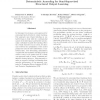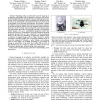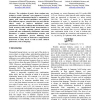1826 search results - page 104 / 366 » Using Random Forests in the Structured Language Model |
EMNLP
2010
14 years 7 months ago
2010
In this paper, we investigate how modeling content structure can benefit text analysis applications such as extractive summarization and sentiment analysis. This follows the lingu...
VL
1997
IEEE
15 years 2 months ago
1997
IEEE
The large number of programming languages in the world is a consequence of the broad spectrum of human preferences for different notational styles and semantic models, which depen...
122
click to vote
JMLR
2012
13 years 7 days ago
2012
In this paper we propose a new approach for semi-supervised structured output learning. Our approach uses relaxed labeling on unlabeled data to deal with the combinatorial nature ...
HRI
2010
ACM
15 years 4 months ago
2010
ACM
—Speaking using unconstrained natural language is an intuitive and flexible way for humans to interact with robots. Understanding this kind of linguistic input is challenging be...
CEC
2005
IEEE
15 years 3 months ago
2005
IEEE
The evolution of music, from random note strings to certain “pleasant” note sequences, is traced in a multi-agent computational model. A community of agents, with some musical ...



